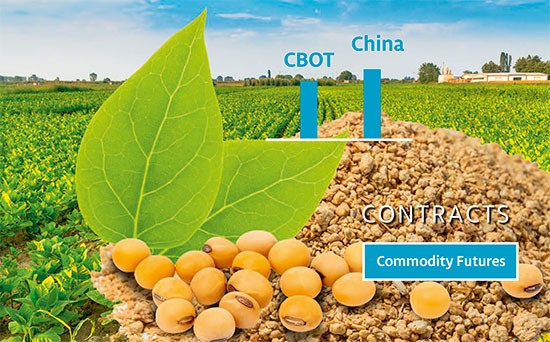Page 2: Opportunities Ahead in Chinese Markets
Commodity markets
China’s commodity markets include three of the world’s biggest five exchanges. According to the Futures Industry Association’s 2020 exchange and contract rankings, Shanghai, Dalian and Zhengzhou rank within the top five largest commodity exchanges, as measured by their trading volumes, along with CME Group and ICE. Focusing on individual contracts, 14 of the top 20 agricultural contracts are in China while 11 of the top 20 metals contracts, and five of the top 20 energy futures contracts are in China. China’s soybean meal and soybean oil contracts are now bigger than CBOT’s.

A growing number of commodities can only be traded in China or have their key markets there, including steel rebar, hot rolled steel, coking coal, thermal coal, PTA (purified terephthalic acid), PVC (polyvinyl chloride); PP (polypropylene), LLDP (linear low-density polyethylene), apples and eggs, some of which are not traded on other international exchanges. In 2020, China introduced 12 new commodity derivative products, and exchanges soon plan to add carbon futures amongst other potential new products. Zhengzhou Futures Exchange chairman, Lu Dongsheng, addressing the China Futures Association, announced plans readying a wide range of new futures products, including peanuts, chicken, steel billet, caustic soda and paraxylene – and might develop contracts in potatoes, sunflower seeds, garlic, cement and propylene.
China is also internationalizing more commodity futures.9 At least seven contracts are available to overseas investors: bonded copper futures, crude oil, TSR 20 rubber and low-sulphur fuel oil on the Shanghai International Energy Exchange; iron ore and palm oil on the Dalian Commodity Exchange, and PTA (purified terephthalic acid) on the Zhengzhou Commodity Exchange. There is a long pipeline of other contracts that should soon be internationalised: alumina, ferrochrome, synthetic rubber, refined oil, natural gas, naphtha, corrugated paper, woodfree paper and electric power, Shanghai Futures Exchange (SHFE) Chairman Jiang Yan said at the 18th Shanghai Derivatives Market Forum.
China is also adding a growing number of options on commodity futures: 18 over the past three years, with aluminum and zinc options added in 2020.10 The long-term plan is for all commodity futures to have associated options, according to Fang Xinghai, vice-chairman of the China Securities Regulatory Commission. Crude oil options trading on the Shanghai IFE has just started in June 2021.
Bonds, rates and credit
China’s onshore bond market is the second largest in the world, at $15 trillion,11 of which $9.2 trillion is rates (government bonds, municipal bonds, policy bank bonds and central bank bills) and $5.8 trillion is in corporate bonds (including corporate bonds, enterprise bonds, financial bonds, debt financing instruments and asset backed securities). China’s domestic corporate bond market is second only to the US, which has $10 trillion, and is a similar size to the entire European investment grade market. China’s offshore corporate bonds of $750 billion make up around one third of Asia Pacific corporate debt markets.

Despite offering a useful yield pickup, China’s bond markets remain largely undiscovered territory for overseas investors. Although foreigners can access the main venue – the interbank bond market – via CIBM Direct, foreign ownership is below 1% (3% if one includes government bonds) and derivatives such as credit default swaps (CDS) and repo’s for corporate bonds are somewhat nascent.12 This is changing fast: in April 2021 BNY Mellon became the first US bank to offering triparty repo’s, using Chinese debt bought via Hong Kong’s Bond Connect as collateral.13
Accelerating derivatives development and foreign participation
Whereas the aforementioned market for credit derivatives is in its relative infancy, regulators in China are committed to further developing all financial derivatives markets. “Currently, China’s financial futures and options market is at an early stage of development. It far lags market participants’ growing needs to manage their risks. It also fails to keep pace with China’s economic development and financial reforms,” Fang Xinghai, vice chairman of the China Securities Regulatory Commission, told the China Futures Association in December 2020. At the second Bund Summit in Shanghai also in 2020, he promised to further open capital markets and products, as well as securities, funds and futures.
For instance, China has drafted a new Futures Law, which was supported by the US-based Futures Industry Association. The FIA and its members have requested some clarifications and additions to the law, and are working collaboratively with the National People’s Congress, the China Securities Regulatory Commission, the China Futures Association and others to hone and refine the new law. There are also initiatives to link the interbank and Shanghai/Shenzhen exchange venues for trading bonds in order to widen access.
During the 12th Lujiazui Forum 2020, the Chairman of the CSRC reiterated the message that China is inviting investors globally to participate more widely and deeply in the Chinese market. A much wider variety of asset managers, including smaller and younger firms, can now apply for their own QFII license to directly access most financial markets, and there are no longer quotas on QFII. Asset managers with a good understanding of Chinese markets should increasingly be able to deploy a wider variety of traditional and alternative strategies to them, with capital raised from inside and outside China.
Potential growth of assets
China’s savings of CNY 120 trillion (USD 18.8 trillion) are already around one third of the US total of USD 57 trillion, and China’s savings pool could catch up quite quickly as some predict it could to treble to CNY 320 trillion (USD 50 trillion) by 2030.14
Historically, China’s gargantuan savings ratio was deployed conservatively into relatively familiar and predictable areas: property, bank account savings and various guaranteed return products. Retail investors have also been taking rather more risk with varied results actively picking and trading stocks. Now that wealth management products/cash management products cannot guarantee principal nor promise higher returns than deposits or money market funds and are subject to stricter risk criteria on leverage, credit quality, liquidity, and diversification, investors and banks are moving to NAV based products and accept that they need to tolerate some volatility in their search for higher returns. The explicit objective of the new rules is to educate investors about the risks they are taking. Investors will likely seek diversification in both traditional and alternative strategies.
Control of local asset management companies
The participation of foreign companies may help offer a wider range of investment strategies and a broader variety of business models in terms of culture and governance. Having initially been restricted to minority participation in joint ventures, they can now have full or majority ownership of an asset management, wealth management, securities or futures company in China, including companies advising retail investors, known as fund management companies (FMCs). This opens up access to a wider spectrum of savings pools: including retail fund management, private asset management (segregated accounts), qualified domestic institutional investor (QDII) and offshore investment pending both licensing and quota availability, investment advisory, and possibly basic pension, enterprise annuity investment management, social security fund investment management, and insurance funds.15
Foreign firms can also get involved in securities investment advisory, funds investment advisory, and issuance of securities research reports. In other cases, however, asset managers may still prefer a minority joint venture and some of the largest western asset and wealth managers have entered into distribution partnerships with the biggest Chinese banks, in order to access networks of thousands of branches and millions of customers. It is also now easier for asset managers to avail of the QDLP programme to raise assets onshore to invest outside China.
Conclusions
Given the size and global importance of China’s economy, its wealth and the scale of its capital markets, it already has a major influence beyond onshore markets. Therefore, even where investors are not directly trading China’s onshore markets, it is important to be aware of developments. We believe that China’s financial markets offer an unusual combination of liquidity and diversification benefits, that could make them attractive places for global investors, both for strategic exposure and for exploring directional and relative value alpha opportunities.
The availability and liquidity of financial derivatives, initially focused on commodities, has already expanded to some areas in equities and fixed income. Furthermore, China is steadily taking steps towards opening its financial derivatives markets to the outside world. We believe that as China’s markets become more open to offshore investors, the experience of following their evolution over time will help to provide important context. We expect China’s markets to present attractive opportunities in the future that will be accessible to both onshore and offshore investors. By following market developments today, we believe investors may be better placed to take advantage of opportunities as China’s derivatives markets further open up.
–––––––––––––––––––––––––––––––
About the authors

Mr. Govert Heijboer, Co- CIO of True Partner, has been active as a market maker trading in the European and Asian derivatives markets as well as positional trading since 2003. Govert started as a trader/ researcher at Saen Options in Amsterdam and rose to become the director of derivatives trading and a member of the executive team in 2007. In 2008 he moved to Hong Kong to set up and assume responsibility for all trading activities in the new Saen Options Hong Kong branch office. Govert holds a PhD in Management Science and an MSc in Applied Physics from the University of Twente, Netherlands. He is a founding partner and has worked on the launch of the True Partner Fund since March 2010.

Mr. Tobias Hekster, Co- CIO of True Partner, has been actively trading for the past 21 years in various different roles in several markets across the globe. Starting at IMC in 1998 as a pit trader in Amsterdam, Tobias has established the off-floor arbitrage desk, headed the Chicago office in the transition from floor trading to electronic trading and set up the Asian volatility arbitrage desk in Hong Kong. Tobias holds an MSc in Economics from University of Groningen, Netherlands. Next to his role as Senior Strategist, he taught as an Adjunct Associate Professor at the Chinese University of Hong Kong and as an Adjunct Professor of Financial Practice at National Taiwan University.

Mr. Robert Kavanagh, CFA, Head of Investment Solutions of True Partner, has been in the hedge fund industry since 2004 and joined True Partner in 2019. Prior to joining True Partner he was an Executive Director at Goldman Sachs Asset Management where he spent 15 years within the Alternative Investments & Manager Selection (AIMS) group. Robert has extensive experience investing in hedge funds and working with a wide range of hedge fund investors. Robert is a CFA charterholder and holds a First Class (Honours) BSc in Philosophy and Politics from the University of Bristol, UK, where he was awarded a Social Sciences Scholarship.
–––––––––––––––––––––––––––––––
The publication of this article is available as a PDF. Download it following the link below:
Opportunities Ahead in Chinese Markets>>
–––––––––––––––––––––––––––––––
1. 10 things to know about China equities, Allianz Global Investors, accessed June 2020www.allianzgi.com
2. “The merits of a standalone equity allocation to China”, Willis Towers Watson, November 2020
3. “International investors flock to Chinese assets”, Financial Times, 15 July 2021. One factor affecting the share of assets in Chinese markets may be restrictions on foreign access to Chinese domestic markets. These have historically been significant but many barriers to such access have been reduced or removed in recent years.
4. China to dominate world IPO league in 2020, Nikkei Asia, December 18, 2020asia.nikkei.com
5. Sources: Bloomberg, True Partner. Data from Jan 2007 to July 2021
6. Expanding Access to the A Share Market, Hong Kong Financial Services Development Council, September 2020 www.fsdc.org.hk
7. Sources: Bloomberg, True Partner. Data from Jan 2007 to July 2021.
8. Sources: Bloomberg, True Partner. Data from Dec 2006 to July 2021
9. China opens futures markets further to outside world, Futures Industry Association, November 25, 2020 www.fia.org
10. China launches aluminum, zin options to serve real economy, XinhuaNet, August 10, 2020www.xinhuanet.com
11. The internationalization of the China corporate bond market, ICMA, January 2021; Bond Market Size, ICMA, August 2020 www.icmagroup.org; www.icmagroup.org
12. The internationalization of the China corporate bond market, ICMA, January 2021 www.icmagroup.org
13. BNY Mellon opens 4 trillion repo niche to holders of China debt, Bloomberg, April 13, 2021 www.bloomberg.com
14. Data from Oliver Wyman cited in “Foreign asset managers are eyeing China’s vast pool of savings”, The Economist, June 12, 2021www.economist.com
15. China market liberalisation for global asset managers, HSBC, July 16, 2020www.gbm.hsbc.com
- AI Top or Slop: When Markets Reach Peak Magnificence
- The Hedge Fund Journal features True Partner's award-winning volatility strategies
- True Partner Fund wins award for strong performance
- True Partner releases new thought piece focused on Dutch pension funds
- True Partner Fund nominated for best performing relative value fund
- Bloomberg article highlights True Partner’s strong performance in April and year-to-date
- Bloomberg Publication: True Partner Volatility Hedge Fund Gains 5.9% During April Rout
- True Partner to join the London Volatility Investing Event 2025
- Wat zijn de gevolgen voor pensioenfondsen van een zware beursdaling?
- What would a significant market downturn mean for Dutch pension funds?
- More news articles >
- Go to events >